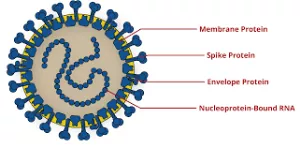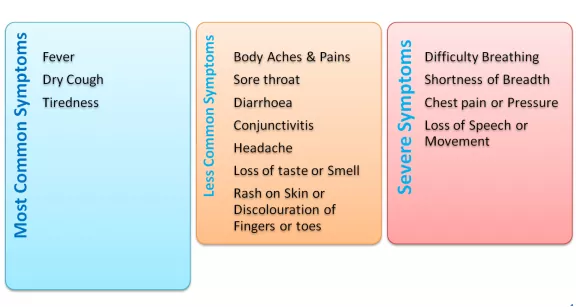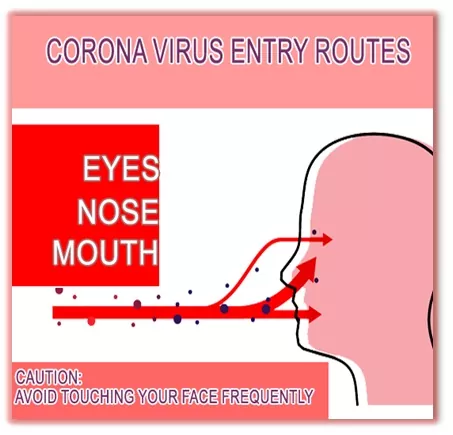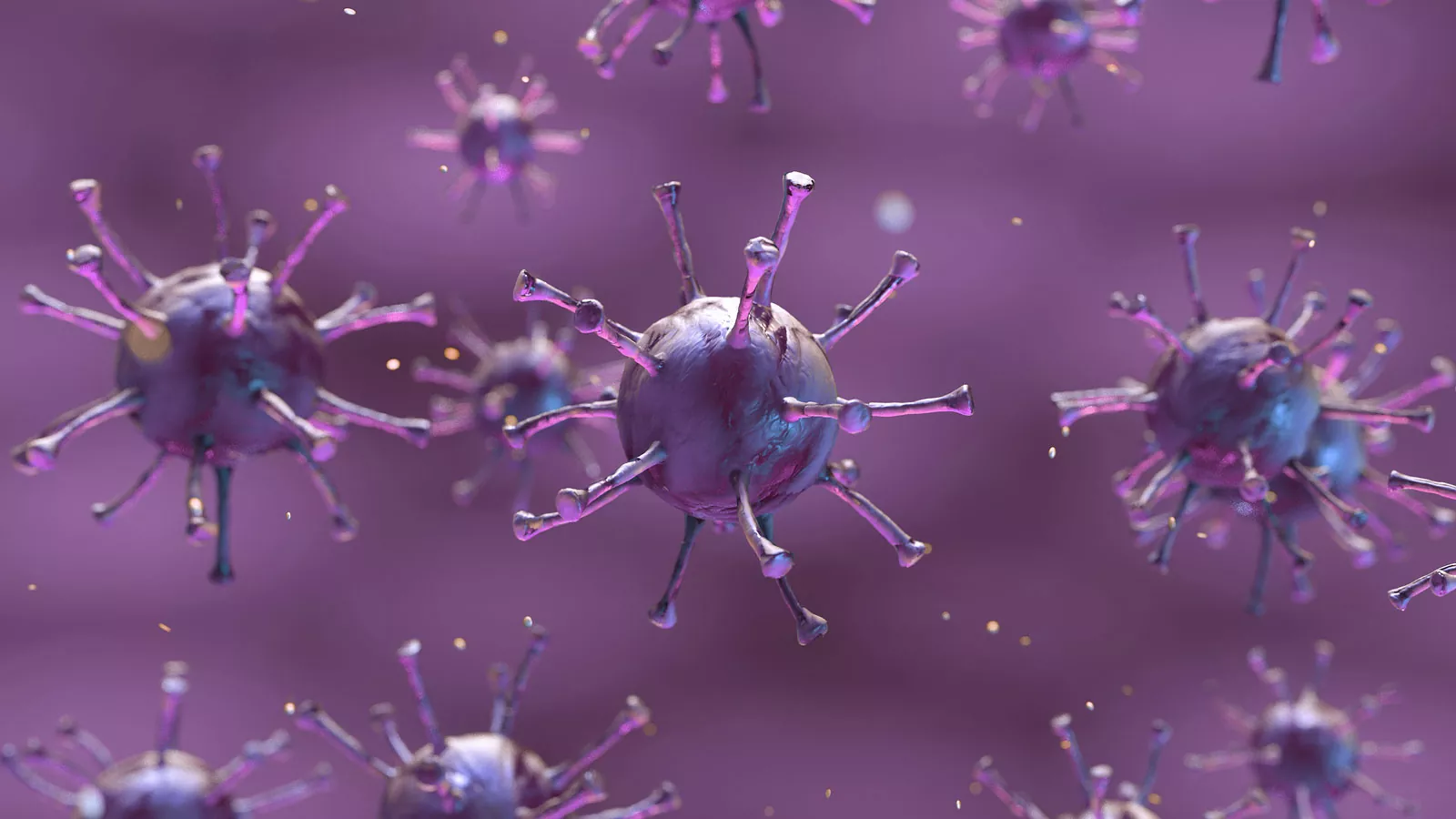Covid-19: Co (Corona) Vi (Virus) D (Disease) 19 (2019)
Covid-19 is an infectious disease caused by corona virus, first identified in late 2019 in the city of Wuhan, China. The disease was described as an endemic as the cases were limited to Wuhan city until early January, 2020 , went on to become epidemic and currently it’s a pandemic affecting most of the countries in the world taking the lives of as many as 2,85,445 by 12th May 2020.
CORONA VIRUS:
These are large group of viruses. They consists of a genetic material which is surrounded by an envelope with protein spikes. Protein spikes give it the shape of a crown which means Corona in Latin. That’s how they get their name “Corona Virus”.

Source: The Nativeantigencompany
Origin:
These viruses mainly circulate in range of animals like Camels, Bats, Cats and Pigs. Being the reservoirs of Corona virus family, these animals get respiratory diseases when catches infection. The virus jumps from Animals to Humans due to various mutations or increased contact between humans and animals. Occasionally, they cause respiratory and sometimes gastrointestinal diseases in humans, when humans catch infection with virus. The symptoms range from Mild to Severe; common cold and pneumonia being mild symptoms. However, some types of Corona Viruses are deadly and cause severe diseases in humans. These types include
SARS-CoV i.e. Severe Acute Respiratory Syndrome Corona Virus (identified in China in 2003)
MERS-CoV i.e. Middle East Respiratory Syndrome Corona Virus (identified in Saudi Arabia in 2012)
SARS-CoV identified to be originated from Civet Cats whereas MER-CoV from Camels
Now the current virus was named as Novel Corona Virus-19 by WHO which was identified in Seafood & Live Animal Market, Wuhan City, China, in December 2019, the origin of which is unknown yet.
PEOPLE AT RISK:
As researchers believe that the origin of Corona virus is associated with animals, live animal market workers are at more risk. People that come in contact with infected persons & contaminated surfaces, those who take care of infected persons like family members and health care professionals are also at risk of developing COVID-19.
In general, though infected with Virus, 80% of the population show mild symptoms or no symptoms based on their immunity. These people don’t need any special medical assistance. Self-isolation/Quarantine is enough for their recovery. Those who have underlying diseases like lung diseases, heart disease, diabetes, kidney/liver failure or any other immuno suppressive disorders are at high risk. They need hospitalization for supportive care.
The prognosis and mortality rate of the disease are unknown yet (WHO)
SYMPTOMS:

COVID – 19 SYMPTOMS (Source: WHO)
CORONA VIRUS ENTRY ROUTES:

TRANSMISSION:

As per the existing evidence, transmission of Covid-19 virus occurs among people through respiratory droplets and contact routes (Liu J, Liao X, Qian S et al.) Airborne transmission was not reported after analysing 75,465 Covid-19 cases (Ong SW, Tan YK, Chia PY et al.)
However, according to WHO, airborne transmission of COVID-19 may also be possible in some cases. When support treatments like Bronchoscopy, Endotracheal intubation, Open suctioning, Nebulization, Tracheostomy etc are performed, airborne transmission may be possible. Otherwise, there is no evidence as to the presence and transmission of virus via natural air or wind.
As per a study, Corona virus is approximately 40 microns in size which is largest of all the other viruses which is making it difficult for the virus to stay in air for longer. Hence they sink to the ground which in turn lead to indirect transmission. Only when aerosol generating procedures and support treatments are performed, there are chances of airborne transmission.
No evidence till date on fecal-oral transmission of COVID-19 (WHO)
DIAGNOSTIC TESTS:
- PCR- Polymerase Chain Reaction Test
- RDT- Rapid Diagnostic test
PCR Explained:
The infection is mainly diagnosed by Polymerase Chain Reaction test(PCR). This test identifies the virus based on its genetic finger print. Upper respiratory specimen is recommended for initial testing of COVID-19 virus.
The acceptable Specimens include:
- Oro-pharyngeal Specimen
- Naso-pharyngeal Specimen
- Nasal Mid-turbimate Swab
- A nasal Swab/ An Anterior Nares
- Naso-pharyngeal Aspirate/Wash
- Nasal Aspirate/Wash
RDT Explained:
There are 2 more evolving tests:
Rapid Diagnostic Tests (RDT) are in wide use now a days because of their quick results.
Type I : One test identifies the antigens or virus proteins present in a sample, collected from Respiratory tract of an infected person. If the antigen is present in sufficient concentration in the sample, it will bind to the antibodies present on a strip and shows a visually detectable sign. The result takes approximately 30 mins.
However, there are number of factors which may leave us in speculation on the accuracy of the test results. Because, WHO says that there are several factors which may alter the test outcome. Such factors include, Quality of the specimen, concentration of virus in the specimen, time of onset of illness, formulation of reagent on the testing kit etc.
Type II : Second type detects the antibodies present in the blood of infected person in response to Virus (antigen). In general, it takes days to weeks for antibodies production in infected person’s body. The time taken for antibody production varies from person to person which in turn affects the test results. At the same time, the strength of the antibody response depends on factors like age, previous or underlying infections like HIV (that suppress the immune system), certain medications, severity of the infection (COVID-19) and nutritional status. (Li Z, Yi Y, Luo X, Xion N, et al)
Hence, even though Rapid Diagnostic Tests give quicker results, their reliability is skeptical. To conclude, Polymerase Chain Reaction testing of Respiratory Tract Samples is most recommended method for detection and laboratory confirmation of COVID-19 virus though it is time consuming (WHO)
TREATMENT (Covid19):
As of now, there is no promising or approved treatment for Covid-19. Currently symptomatic treatment is only available based on the severity of the disease (Covid-19) and underlying chronic illnesses like Respiratory diseases, Hypertension, Diabetes, Kidney/liver diseases, Malignancies, Bone marrow/organ transplants or any other immuno suppressive disorders like HIV.
Caution: It is popular among health care professionals that Hydroxychloroquine, Azithromycin and Antiviral drugs like Oseltamivir, Lopinavir/Ritonavir are showing some positive results in symptomatic treatment. However, combined use of Hydroxychloroquine and Azithromycin leads to QTc prolongation (I.e Delayed Heart chambers filling) which may cause Heart failure. Hence, it is always safe to admit in Hospital and be under the supervision of the Health care professionals when you suspect Covid-19 infection. Don’t go for self-treatment.
PREVENTION:
As there is no treatment or vaccination available for Covid-19, it is advisable to take every possible precaution to prevent the disease from spreading. Following are the precautions that help our family and the society as a whole from not catching Covid-19 infection. We say
“STAY HOME, STAY SAFE”

REFERENCES:
- The Economictimes ,2020 Available at:https://m.eco
nomictimes.com/news/international/world-news/wuhan-shrimp-seller-identified-as-coronavirus-patient-zero/articleshow/74870327.cms.
- Li Z, Yi Y, Luo X, Xion N, et al. Development and clinical application of a rapid IgM-IgG combined antibody test for SARS-Cov-2 infection diagnosis. Journal of Medical Virology
- Liu J, Liao X, Qian S et al. Community transmission of severe acute respiratory syndrome corona virus 2, Shenzhen, China, 2020
- Ong SW, Tan YK, Chia PY, Lee TH, Ng OT, Wong MS, et al. Air, Surface environment contamination by severe acute respiratory syndrome coronavirus 2 (SARS-CoV-2) from a symptomatic patient. JAMA. 2020 Mar 4
- World Health Organization, 2020 Available from: http://www.who.int/new-room/commentaries/detail/modes-of-transmission-of-virus-causing-covid-19-implications-for-ipc-precaution-recommendations.
Also read: Pregnant Women and Covid-19. We have some facts

